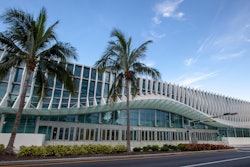
Security has always been an important component of event planning, but the frequency of violent incidents at public venues in recent years has heightened awareness and concern. Events such as trade shows and conferences are considered soft targets, meaning they are relatively unprotected and vulnerable. On Thursday, the International Association of Exhibitions and Events hosted a webinar on active shooter incidents to help planners understand common characteristics of these tragedies and steps they can take to maximize security at their events. United Security Services vice president/director of security specialist Bill Callaghan and security specialist Ken Grandy (who has worked for U.S.S. and ComPsych) led the presentation. Here are some of the tips they shared:
1. Ask to see your venue’s active shooter response plan. If you are contracting for additional security, ask for that company’s plan also. Planners should feel confident that the plans are thorough.
2. Find out how venue personnel will allow access for emergency responders and how they will notify you about the situation.
3. Determine if the venue has safe rooms, and find out about existing rally points for evacuations. Callaghan said planners may not want to publish their event’s rally points since that could allow the shooter to know where large numbers of attendees will be congregating in an emergency.
4. Create a crisis communications plan with your event team. Also consider asking for a secondary contact for each attendee; for example, get information on someone in the attendee's home office who is not at the event.
5. Think about if you have any controversial companies exhibiting on the show floor or any controversial speakers. If so, you may need to increase security and ensure access is only to credentialed attendees.
6. Consider discussing security with your exhibitors and vendors and ask if any of them are aware of potential risks; for example, former employees who may be angry.
7. Take steps to “harden” the target by putting security personnel in high-visibility locations and at access points such as entryways and loading docks.
8. Private security officers may not be armed, so consider supplementing them with off-duty officers hired from local law-enforcement agencies.
9. Be on the lookout for suspicious activity, such as a vehicle parked in an odd location, unattended packages or luggage, or open windows or doors that are usually closed.
10. Also notice if people ask unnecessary questions about the building’s security, personnel, shift changes, and if they appear to be loitering, taking photos of the building, or sketching floor plans.
11. If suspicious activity is noticed, contact local authorities and describe what you saw. It may be innocent behavior, but leave it to law enforcement to make that determination.
12. If an active shooter is present, there are three possible ways to respond: run, hide, or fight. The best option is to run. Leave your belongings behind and get out as quickly as possible. If you can’t get out safely, try to hide someplace where you can lock a door or conceal yourself. Also remember to silence your phone. As a last resort, attempt to incapacitate the shooter using improvised weapons, such as chairs or other heavy objects.
13. When calling 911 to report an active shooter, try to provide the location of the shooter, the number of shooters, a physical description of the shooter, the number and type of weapons being used, and the number of potential victims and their locations.



















